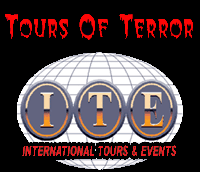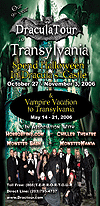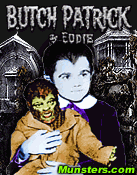
to Transylvania...' Jonathan Harker
by Werner Hirsch Contributions: Kitty Burns and Stacey Leigh Mascia
Photo credits: All Photos Courtesy Werner Hirsch
Before I begin my report I must congratulate Tours and Events for one of the best organized tours we've ever taken. Our Romanian guide, Radu, who is so knowledgeable about everything Romanian and Draculean, was superb. His degrees in history and sociology, and his knowledge of English serve him well, and make him outstandingly qualified as a professional guide. Many of us went on this trip because of our fondness for Stoker and all things vampire-ish, others came to see the country and get to meet its people. Both groups were more than adequately satisfied. In general, this was one of the best tours we've ever taken.
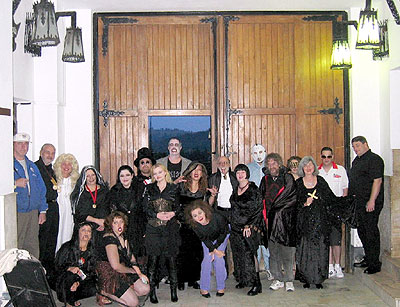 When we arrived at the airport, representatives from Tours of Terror were there to greet us with bags filled with vampire goodies and horror magazines for the flight.
When we arrived at the airport, representatives from Tours of Terror were there to greet us with bags filled with vampire goodies and horror magazines for the flight.We all arrived at the Bucharest Airport where we were met by our very efficient Romanian guide, Radu. We were very quickly led to our waiting bus and soon left for our hotel, getting a brief city tour along the way. While we were on our way, Radu, never without his cell phone, was preparing the hotel for our arrival. When we got there, the attendants were waiting for us at the curb and promptly carried our luggage into the lobby. We were quickly given our room assignments and handed keys. Later that evening we would all meet for dinner.
The elegant Grand Hotel Bulevard was built in 1896, just one year before Bram Stoker wrote Dracula. It was decorated in Louis XIV style, and although the hotel had obviously seen better days, its restored elegance let us experience first-hand the grandeur of the Victorian Age. Our first 'getting acquainted' dinner was in its beautiful colonnaded, gold-leafed grand ballroom. Here we got a chance to introduce
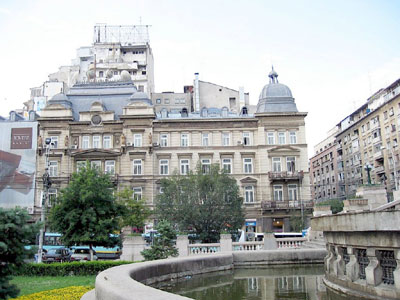 ourselves and explain why we wanted to be on this trip. We were all there for different reasons. Some were there just because a traveling companion didn't want to go alone and some were talked into the trip by a relative, but all were there to have a good time. The ages of the group also varied greatly. Some were in their early 20s, others in their late 60s. Some were in the military while others were office workers and retired schoolteachers. We weren't at all sure just how this would pan out. We felt that this group would surely split into cliques, but nothing could have been further from the truth. It was an extremely homogeneous and sociable group. We know that many friendships were formed and that many of us will continue to correspond for a long time to come. Stacey named us the 'legend-seekers.'
ourselves and explain why we wanted to be on this trip. We were all there for different reasons. Some were there just because a traveling companion didn't want to go alone and some were talked into the trip by a relative, but all were there to have a good time. The ages of the group also varied greatly. Some were in their early 20s, others in their late 60s. Some were in the military while others were office workers and retired schoolteachers. We weren't at all sure just how this would pan out. We felt that this group would surely split into cliques, but nothing could have been further from the truth. It was an extremely homogeneous and sociable group. We know that many friendships were formed and that many of us will continue to correspond for a long time to come. Stacey named us the 'legend-seekers.'On our first evening in Bucharest, Radu took a group of us for a short walk through the oldest section of the city. Here archaeologists have uncovered the Old Princely Court of Vlad Tepes (Dracula), the Palatul Voievodal, which dates to the 14th Century and is now undergoing restoration. Nearby are the remains of one of Dracula's palaces and the oldest church in the city (1546). After a short discussion and a further look around the neighborhood we stopped in the large courtyard café of the very picturesque Hanul Manuc Inn (built 1808) for our first taste of good Romanian beer and wine. The Hanul Manuc is the oldest hotel in Bucharest. Radu explained that Bucharest is similar to Rome in several ways, it's also built on seven hills and it's virtually impossible to dig anywhere in the city without uncovering the remains and relics of its older inhabitants, keeping the archaeologists very busy.
After a typical eastern European breakfast, we boarded the bus for our trip north towards Transylvania. On our way we got to see more of Bucharest, the Paris of the Balkans. We stopped to see one of the largest city squares in Europe surrounded by some of Romania's government buildings. The largest was the Presidential Palace. It was called the 'House of the People' by its builder, the communist dictator, Nicolae Ceaucescu, but the people facetiously call it Casa Nebunului - the 'Madman's House.' With over 1000 rooms it is the third largest building in the world and is second in size to our Pentagon.
As we headed out of the city we passed the Ploesti oil fields and refineries. These fields were bombed heavily by allied troops during World War II since they supplied fuel for the German army. During the infamous raids many aviators lost their lives. We passed a small, well-maintained cemetery where many of these heroes lie buried.
On the coach, we played a 'getting to know you' game supplied by our hostess, Kitty Burns ('Mina Harker' of the S.F. Vamp Tour). As we were driving, as if someone rang the cow school bell, out of nowhere a bunch of cows came down the street. Of course, the cows have the right of way. This cracked us up... none of us ever had to slow down to let cows go by before.
Nico, our fabulous bus driver, maneuvered the bus down some narrow dirt roads which seemed only slightly smaller than the bus. We made our first major stop at the Snagov Monastery. The monastery, or at least the remains
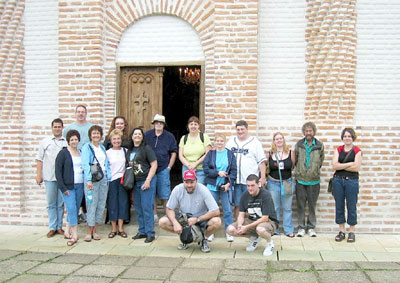 of the monastery, is situated on an island in Snagov Lake. In order to get there, several locals with rowboats ferried us to the island, three or four at a time. The small church, founded in the Fourteenth Century and rebuilt in the Sixteenth, is beautifully decorated with colorful and elaborate frescos that cover every square inch of the interior. Supposedly founded by his grandfather, the monastery served as a retreat and 'safe house' for Prince Vlad and members of his family. It is said that his decapitated body was secretly reburied under a marble slab in the center of the church in front of the screen. In the 1930s archaeologists opened the tomb but found only animal bones. Perhaps he rose from his grave and is still wandering about. His grave is properly decorated with his picture and fresh flowers. Vlad is still revered by Romanians as a unifier of warring Romanian nobles and as the protector of the land from Turkish invaders. The building has been recently restored and is an exquisite example of medieval Orthodox church architecture.
of the monastery, is situated on an island in Snagov Lake. In order to get there, several locals with rowboats ferried us to the island, three or four at a time. The small church, founded in the Fourteenth Century and rebuilt in the Sixteenth, is beautifully decorated with colorful and elaborate frescos that cover every square inch of the interior. Supposedly founded by his grandfather, the monastery served as a retreat and 'safe house' for Prince Vlad and members of his family. It is said that his decapitated body was secretly reburied under a marble slab in the center of the church in front of the screen. In the 1930s archaeologists opened the tomb but found only animal bones. Perhaps he rose from his grave and is still wandering about. His grave is properly decorated with his picture and fresh flowers. Vlad is still revered by Romanians as a unifier of warring Romanian nobles and as the protector of the land from Turkish invaders. The building has been recently restored and is an exquisite example of medieval Orthodox church architecture.
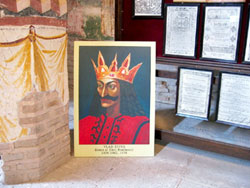
After returning from the island and watching John toss Mardi Gras beads to seemingly poor but happy and eager children, who were crowded around to see the bus and the strange Americans, we again proceeded on our way. Our next stop would be in Brasov at the famous Bran Castle which once belonged to Dracula's ancestors and where Dracula himself was later imprisoned. The weather was rainy, dark, and gloomy...perfect! In stark contract to the darkened sky, there were fields of sunflowers.
Bran could have come right out of a fairy tale. Built on a mountaintop in the Thirteenth Century by Teutonic knights, it is replete with many steeples, turrets, and battlements, dark passages, and secret rooms and stairways. We saw period-furnished living quarters, bedrooms, and kitchens. We also stood in the incredibly small cell, barely three feet wide, where Dracula was held prisoner during his stay at Bran. It was not hard to imagine medieval castle servants drawing water from the old well in the picturesque courtyard. From the heights of the fortification we could look over the entire town of Brasov and its surroundings and picture invading forces trying to make their way upward. The only things missing were the sounds of the warrior's screams and the thundering hoof beats as the knights fought their way up the hill.
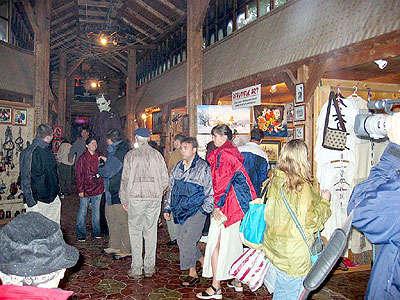 After the tour we spent about an hour or two shopping for souvenirs and trinkets in the Gypsy markets at the base of the castle. Needless to say, the souvenirs were mostly geared to Dracula fans. There were even roaming figures (a la Disney) such as Frankenstein's monster and the Werewolf. All were willing to pose for pictures (for a tip, of course) and for a quick nip on the neck.
After the tour we spent about an hour or two shopping for souvenirs and trinkets in the Gypsy markets at the base of the castle. Needless to say, the souvenirs were mostly geared to Dracula fans. There were even roaming figures (a la Disney) such as Frankenstein's monster and the Werewolf. All were willing to pose for pictures (for a tip, of course) and for a quick nip on the neck.Not far from Bran we stopped to eat at the Vila Craiasa, a quaint country inn where Radu had arranged a typical Romanian peasant meal for us. Again, with extreme planning efficiency, the restaurant staff was awaiting our arrival, and greeted us with shots of plum brandy ("tzuica") as we entered the front door.
We spent the night in Brasov at the Aro Hotel. The name Aro, we learned, was an acronym for American/Romanian so called because of the partnership of its founders. The hotel was very nice and comfortable. But what's with the beds in Romania? They're only about a foot high. It's easier to stumble over them than to stumble into them!
A walking tour of Brasov took us to the main square where the oldest commercial building is dated 1545. At one time Dracula made his headquarters here. It was also here in the square where Vlad impaled thousands of his enemies while he enjoyed a banquet in their midst. Obviously this was one of the events that helped to form the basis for the Dracula/vampire legend. Ah, the ambiance of rotting corpses.
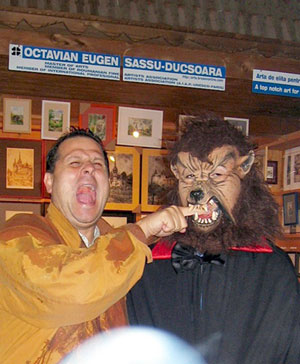 At one end of the square is the well-known 'Black Church' which was built in 1383. Although it is no longer black, it was called this after a catastrophic city fire in 1689 darkened its walls. The church, built as a Catholic edifice, was converted to a Lutheran church by the German Saxons when they occupied Transylvania. It is the largest Gothic church between Vienna and Constantinople. One of its bells is the largest church bell in all of Romania and its organ is one of the biggest in South-Eastern Europe.
At one end of the square is the well-known 'Black Church' which was built in 1383. Although it is no longer black, it was called this after a catastrophic city fire in 1689 darkened its walls. The church, built as a Catholic edifice, was converted to a Lutheran church by the German Saxons when they occupied Transylvania. It is the largest Gothic church between Vienna and Constantinople. One of its bells is the largest church bell in all of Romania and its organ is one of the biggest in South-Eastern Europe.Walking toward the city walls we passed the beautifully restored Brasov Synagogue. Although we didn't have time to go inside, its interior is even more elaborate than its exterior. We soon reached one of the gates to the old city. Here we could see some of the magnificent ancient buildings which lined the old city walls.
After a brief bus ride we arrived in Sighisoara, the birthplace of Vlad Tepes (Vlad the Impaler), better known to us all as Dracula. We saw the house where he was born which is now a cozy restaurant. A short walk took us to the Thirteenth Century Sighisoara Citadel. The citadel is now a UNESCO World Heritage Site and is being preserved as an outstanding example of a small, fortified city. Just being there surrounded by the medieval buildings was like walking into a living fairy tale. It was certainly the most impressive of any 'old city' quarter that we have seen in Europe. It was not hard to imagine the area bustling with peasants patronizing the merchants in their shops and the vendors in the square. It was surrounded by walls and towers, including a tower with an animated clock that was built in 1360. It's probably been rebuilt several times since then but it still strikes the hours while its figures prance about.
Most of the old citadel is now filled with shops, restaurants, and a few museums. Radu took us to an outdoor restaurant where he had arranged to have a troupe of actors portray a witch trial for us. Although the presentation was in Romanian, Radu did some translating and the rest wasn't hard to imagine. The 'witch' was brought in, accused, and put on trial. It had a happy ending though when the poor woman was released. After the show some of us posed with the willing actors.
Next was a visit to an old cemetery. This was a great locale for Mike and Shelley to celebrate their 10th anniversary.
Unfortunately it was some 150 steps up the side of a hill (or through the 'haunted staircase') and some of us didn't feel that we were up to the climb. Those who did venture upward reported that it was well worth the ascent for the chance to see some of the ancient graves and to gaze over the city. The rest of us returned to the Casa Dracula for a refreshing drink... beer - not blood.
Our next destination was Bistrita where we checked in at the Coroana de Aur Hotel (The Golden Crown). This hotel is supposedly on the same spot that is described by Bram Stoker as the place where Jonathan Harker stopped for a meal on his way to Dracula's castle. As we entered the hotel's dining room, aptly named the Jonathan Harker Salon, we were greeted by a devil-costumed hostess who gave each of us a glass of warm, blood-red, plum brandy. The meal consisted of the same Robber Steak that was served to Jonathan in the story along with other accompaniments such as Mamaliga (Romanian polenta), vegetables, wine, and coffee. For dessert we had red, devil-decorated, Dracula cake. After dinner some of us gathered in the lobby for an impromptu beer party. It was a great evening.
The next morning we had some free time to explore the city and do some shopping before we boarded the bus on our way to Dracula's Castle by way of the Borgo (actually Bargau) Pass. It was just as Stoker had described it. As we drove through the pass we came upon a band of Gypsies who had set up camp alongside the road. We persuaded Radu to stop the bus and let us have a look. As soon as the bus parked on the side of the road, a bunch of kids clambered up the embankment from their camp to see what the passing strangers had to offer. Several of us gave them candy, and John passed out some more of his Mardi Gras beads. The children fought furiously over these, punching and shoving to tear them away from each other. The squabbling was so intense that we suspected that they were ordered by their parents to get as much as they could so that the adults could peddle the booty elsewhere. It seemed that the group survived mostly by collecting scrap metal and other discarded items and reselling them. Our stop there was surely a once-in-a-lifetime experience. Radu admitted that seeing such a camp was extremely rare, even for him.
It was not long before we approached Dracula's Castle...or rather, the Hotel Castle Dracula. This was a modern facility built in the 1970s according to the plans of an old castle which once stood on the same mountain top. Although there were farmers living in the area and a small convent nearby, the hotel seemed very isolated from all modern civilization. The view of the mountains and the surrounding countryside from the barroom at the top of its rustic tower was magnificent...as were the drinks. Our overnight stay here would be, in my opinion, the highlight of our trip.
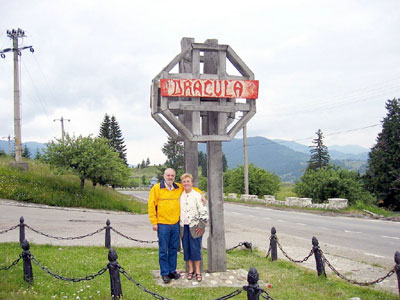 Because we arrived early in the day we had plenty of time to scout out the area and to shop for trinkets at the adjoining gift shops. We visited the nearby convent of Orthodox nuns and admired their beautiful chapel. The people here, as elsewhere in Romania, were all very friendly, whether they spoke English or not. When we stopped to admire the flowers growing in a backyard garden, the elderly lady of the house rushed outside to pick some and give them to her, refusing any tip or compensation. It just made her happy to have been able to please us.
Because we arrived early in the day we had plenty of time to scout out the area and to shop for trinkets at the adjoining gift shops. We visited the nearby convent of Orthodox nuns and admired their beautiful chapel. The people here, as elsewhere in Romania, were all very friendly, whether they spoke English or not. When we stopped to admire the flowers growing in a backyard garden, the elderly lady of the house rushed outside to pick some and give them to her, refusing any tip or compensation. It just made her happy to have been able to please us.Since dinner would be late that night (9:00pm) we all decided to have lunch in the hotel's restaurant. The food was great, large portions, and cheap (How was that Steak Tartare, Brandon?). That evening our dinner would be a banquet, costume ball, and party all rolled into one. Most of us had brought suitable Draculean outfits for the affair. In addition to the imaginative costumes, many of us sported sharp fangs and appropriate deathly-pale makeup, blood stains, and bite marks in just the right places. We all agreed that John, the teacher from upstate New York, looked the best; just like Gary Oldham in the film 'Bram Stoker's Dracula.'
The dinner, served in a special downstairs dining room, was elegant. Everything from the table
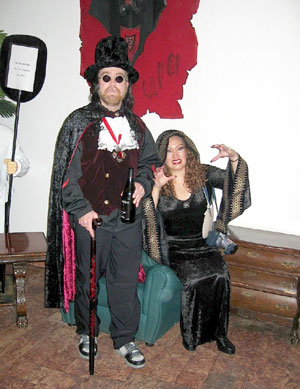 settings to the flaming food was superb. We were also entertained by a trio of Romanian folk musicians who serenaded us. What we thought was dinner turned out to be just the hors d'oeuvres. Following the appetizers we were led outside where the staff had prepared a huge bonfire for us. We each received long spits strung with meat and were invited to roast our own over the embers. They also servedus wine and other accompaniments while the musicians played. Nobody seemed to mind the chill in the air, as the fire and the wine warmed us all.
settings to the flaming food was superb. We were also entertained by a trio of Romanian folk musicians who serenaded us. What we thought was dinner turned out to be just the hors d'oeuvres. Following the appetizers we were led outside where the staff had prepared a huge bonfire for us. We each received long spits strung with meat and were invited to roast our own over the embers. They also servedus wine and other accompaniments while the musicians played. Nobody seemed to mind the chill in the air, as the fire and the wine warmed us all.A few people took left-over scraps of meat and fed them to some of the wild dogs in the area, much to the amusement of the watching locals. It turned out that the dogs weren't dogs at all, they were wolves! The wolves, together with the bats flying overhead, certainly made the setting appropriate to our visit. When we finally returned to the dining room we had more drinks, finished our dinner, had more drinks, had dessert, and had some more drinks while we listened and danced to the music played by the DJ. We were also entertained by Kiki, who had written a song especially for this occasion and sang it for us...kudos Kiki!
At the stroke of midnight Radu asked us to go down to the cellar for a special treat. We made our way down a dark, narrow stairway and even darker and narrower halls. At the bottom we were escorted into a small room which contained a coffin. It would be no surprise if our screams were heard by the secluded nuns in the convent. None of us wanted to go to sleep. The party finally ended at 2 or 3am.
The following morning, after some last minute shopping at the gift stands, we were again on the bus. Our next destination was Sibiu.
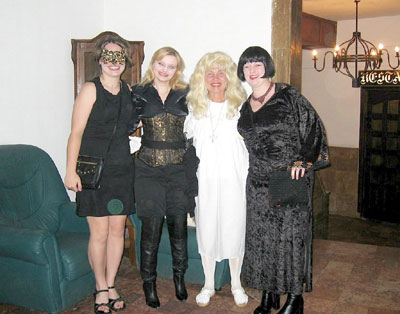 After Nico skillfully maneuvered the large bus around several cows walking along the narrow road and after dodging many horse-drawn wagons, he finally dropped us off at our hotel and we checked into our rooms. From our window we could hear crowds of people and lots of noise that seemed to be not too far away. Looking around, we could see what appeared to be a whole city block filled with café umbrellas and that seemed to be the source of the tumult. Since we had nothing scheduled for that evening a few of us wandered over there to see what was going on. It turned out to be a beer festival of some sort with lots of food stands, a few carnival rides, and a music stage. It was so mobbed that it was literally impossible to force our way through the mass of people. We had to skirt the crowd in order to find our way to a food stand, or rather a beer stand, where we could sit for a while and listen to lively Romanian folk music. We had a few good bottles of Romanian Ursus beer and some delicious, sweet, sugar-coated tubular pastries, Kurtos Kalacs (Hungarian, but very popular in this part of Transylvania). We spent the next hour or so strolling the streets before turning in for the night.
After Nico skillfully maneuvered the large bus around several cows walking along the narrow road and after dodging many horse-drawn wagons, he finally dropped us off at our hotel and we checked into our rooms. From our window we could hear crowds of people and lots of noise that seemed to be not too far away. Looking around, we could see what appeared to be a whole city block filled with café umbrellas and that seemed to be the source of the tumult. Since we had nothing scheduled for that evening a few of us wandered over there to see what was going on. It turned out to be a beer festival of some sort with lots of food stands, a few carnival rides, and a music stage. It was so mobbed that it was literally impossible to force our way through the mass of people. We had to skirt the crowd in order to find our way to a food stand, or rather a beer stand, where we could sit for a while and listen to lively Romanian folk music. We had a few good bottles of Romanian Ursus beer and some delicious, sweet, sugar-coated tubular pastries, Kurtos Kalacs (Hungarian, but very popular in this part of Transylvania). We spent the next hour or so strolling the streets before turning in for the night.In the morning Radu took us for a walking tour of the medieval
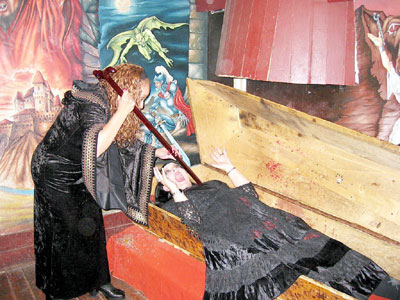 quarter of the city. Just past the old main square we stood on the Liar's Bridge at the city wall while Radu gave us its history. The legend is that if anyone standing on the bridge tells a lie, the bridge will collapse. It has been (and still is) a favorite meeting place for merchants, lawyers, and lovers who probably suspected that the bridge wouldn't really fall, and therefore anything they promised there just had to be true. Even Ceausescu spoke from here.
quarter of the city. Just past the old main square we stood on the Liar's Bridge at the city wall while Radu gave us its history. The legend is that if anyone standing on the bridge tells a lie, the bridge will collapse. It has been (and still is) a favorite meeting place for merchants, lawyers, and lovers who probably suspected that the bridge wouldn't really fall, and therefore anything they promised there just had to be true. Even Ceausescu spoke from here.Near the bridge is the Evangelical Church. The church is a prime example of Gothic architecture and decoration and is maintained by the German government because of its unique features. To a group such as ours though, its prime importance lies in the fact that Dracula's only legitimate son, Mihnea, is buried there. Also entombed in the church is the Saxon nobleman, Valentin Franck von Frankenstein. The author Mary Shelley heard about him from a friend, and, presumably, because of the ungainly features of his sons (due to a genetic disorder), he became her model for Dr. Victor Frankenstein. Shelley always claimed she wrote the story based on a dream.
Sibiu has one more claim to fame. It is called Hermannstadt in German, named for Hermann, the Pied Piper, who supposedly led the children out of Hamelin and through an underground tunnel which emerged in this city. Continuing on our journey, we stopped at the Cozia Monastery. The Byzantine-style monastery was built in the 1380s. Of the original complex, only the chapel remains today. It was built by Mircea the Elder, the grandfather of Prince Dracula, and a painting of grandpa graces one of the frescos inside the church. He is also buried here. It is still a working monastery and church, and there is a nearby shed where votive candles can be lit. The monastery is certainly worth visiting, not only because of the Dracula connection, but also because of its beautiful architecture and its beautiful surroundings (and because it's a good restroom stop!).
Our next stop was also a highlight of the tour, especially for the Dracula fans. We would visit the ruins of the real Dracula's
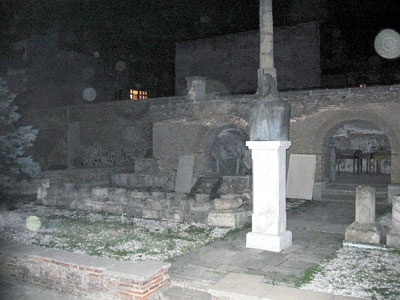 castle. Like most castles this too was built on a mountaintop and required a climb of over 1500 steps to reach it. I'm sure Donald will remember this birthday forever! Some of us chose to explore the nearby town rather than to risk total exhaustion. We spent a few leisurely hours strolling while we waited for the bus to pick us up. Mike, who was with us, decided that it would be a nice gesture if we bought a case of beer for the rest of the crew to refresh them after their arduous climb. We all chipped in for the brews, which were well received by the tired returnees.
castle. Like most castles this too was built on a mountaintop and required a climb of over 1500 steps to reach it. I'm sure Donald will remember this birthday forever! Some of us chose to explore the nearby town rather than to risk total exhaustion. We spent a few leisurely hours strolling while we waited for the bus to pick us up. Mike, who was with us, decided that it would be a nice gesture if we bought a case of beer for the rest of the crew to refresh them after their arduous climb. We all chipped in for the brews, which were well received by the tired returnees.When we boarded the bus again we were on our way back to Bucharest. Our tour would soon be over, but there was still one more adventure to come. The bus made its way back through the Ploesti oil fields and back to the Hotel Bulevard from where we had started. That night Radu took us to the Count Dracula Club for our 'farewell' dinner.
The Dracula Club is located in the downstairs of an old mansion. Lit by candles, the walls of the several small rooms are decorated with Vlad Tepes pictures and memorabilia, antlers, and bear, boar, and wildcat skins. These artifacts supposedly came from an older gentleman who did his hunting near the Borgo Pass. We began eating, and suddenly the Count himself appeared as the candles in his silver candelabrum flickered. He spoke of his battles with the Turks and of the Order of the Dragon and reminisced about his native land and his beloved castle in the Carpathians. Moving about the tables he ended his presentation by declaring, in Stoker's words (and in Bela Lugosi's accent), 'I have dined already.' He continued to mingle and chat with our small crowd and, in good fun, bit willing victims on the neck and posed for photos. The evening was most enjoyable and also gave us a chance to formally thank our guide, Radu, and our driver, Nico, for a job extremely well done.
The tour was one of the most interesting and best managed (and fun) that I have ever taken. As Stacey put it, we got much more than our money's worth on this trip. This was a vacation to remember forever... not just because it was gothic and groovy... but because it reminded us that the world is a very large and interesting place filled with history and promise. I'm sure everyone in the group would recommend it highly to anyone with even the slightest interest in the historical Dracula, or in medieval Europe.
|
|
||

|
 |
|
Copyright © International Tours & Events LLC. All rights reserved







